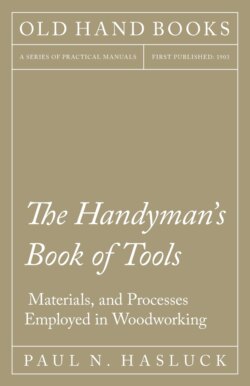Читать книгу The Handyman's Book of Tools, Materials, and Processes Employed in Woodworking - Paul N. Hasluck - Страница 51
На сайте Литреса книга снята с продажи.
USING CHISEL BEVEL DOWNWARDS.
ОглавлениеWhen obstacles render it necessary to use the chisel as in Fig. 131, an increased effort is required to make the cut. The vertical component e now is opposed by the resistance to crushing of the amount of material covered by the oilstone bevel. Since this is small, the material will be considerably compressed; and if the oilstone bevel be thrust along whilst it is held in a horizontal position, the crushing of the material as the bevel moves will add a downward-acting vertical component to the motion, and so the paring will increase in thickness and the surface will not be cut horizontally. To prevent this, the chisel must be so inclined that the oilstone bevel takes the direction x, and thus the downward motion due to the crushing is exactly balanced by the upward motion due to the direction x. But this crushing cannot take place without absorbing work; so that a paring of given thickness requires much more force when produced in this way than with the method shown by Fig. 130. An additional reason why more force is required is that only the horizontal component of A is now available for actually cutting, whilst the vertical component of A goes to increase the force acting against D, and therefore increases the crushing action. Moreover, the component f is greater, owing to the increased angle of the cutting edge. The double-bent tools used by the carver have the oilstone bevel merged into the grindstone bevel, so as to give an extended bearing surface, and therefore produce less crushing, and so require a smaller expenditure of power.
Fig. 132.—Equilibrium of Forces in using Knife.
